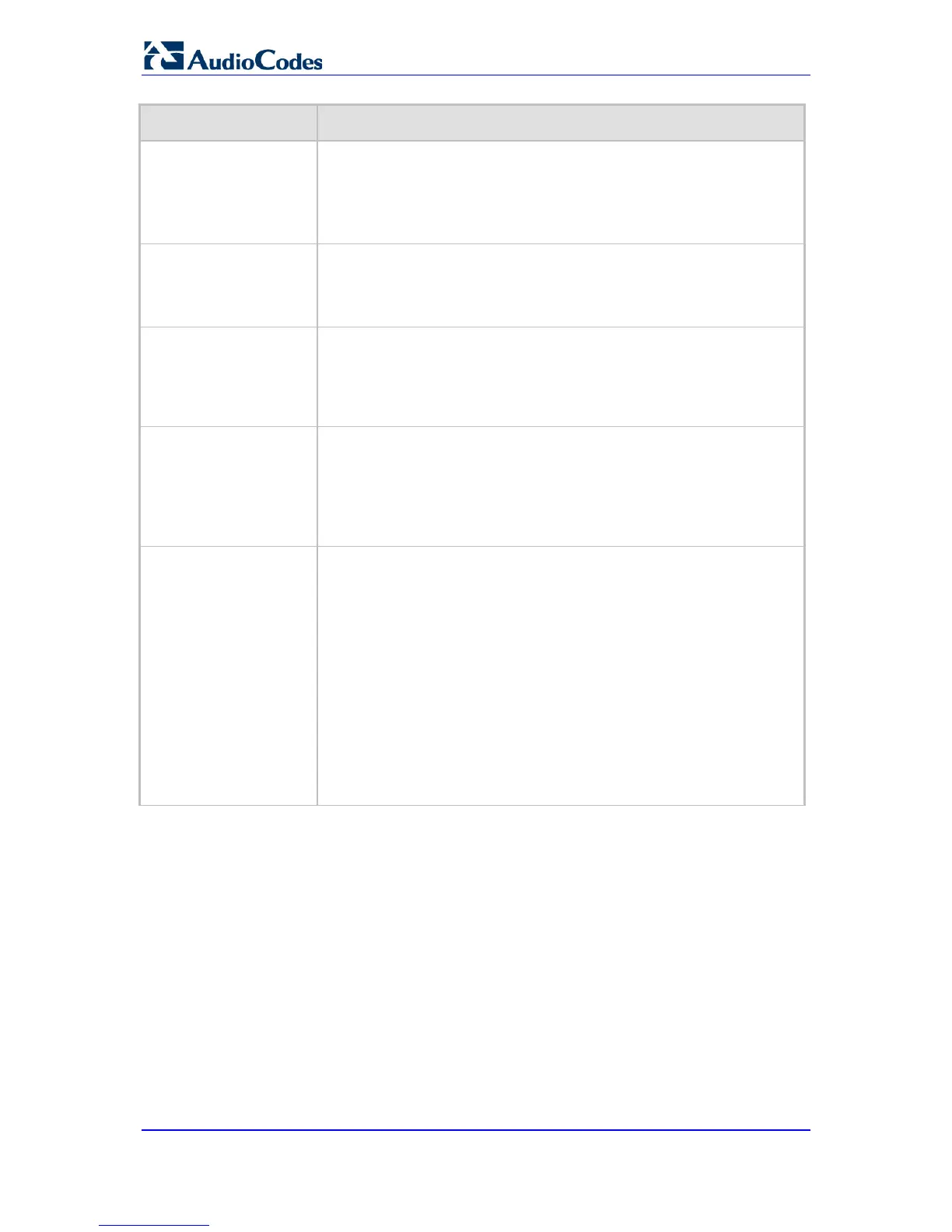Parameter Description
Request Direction
CLI: request-direction
[SBCAdmissionControl
_RequestDirection]
Defines the direction of the SIP request to which the rule applies.
[0] Both = (Default) Rule applies to inbound and outbound SIP
dialogs.
[1] Inbound = Rule applies only to inbound SIP dialogs.
[2] Outbound = Rule applies only to outbound SIP dialogs.
Limit
CLI: limit
[SBCAdmissionControl
_Limit]
Defines the maximum number of concurrent SIP dialogs per IP Group or
SRD. You can also use the following special values:
[0] 0 = Block all these dialogs.
[-1] -1 = (Default) No limit.
Limit Per User
CLI: limit-per-user
[SBCAdmissionControl
_LimitPerUser]
Defines the maximum number of concurrent SIP dialogs per user
belonging to the specified IP Group or SRD. You can also use the
following special values:
[0] 0 = Block all these dialogs.
[-1] -1 = (Default) No limit.
Rate
CLI: rate
[SBCAdmissionControl
_Rate]
Defines the rate at which tokens are added to the token bucket per
second (i.e., token rate). One token is added to the bucket every 1000
divided by the value of this parameter (in milliseconds).
The default is 0 (i.e., unlimited rate).
Note: The token bucket feature is per IP Group, SRD, SIP request type,
and SIP request direction.
Max Burst
CLI: max-burst
[SBCAdmissionControl
_MaxBurst]
Defines the maximum number of tokens (SIP dialogs) that the bucket
can hold. The device only accepts a SIP dialog if a token exists in the
bucket. Once the SIP dialog is accepted, a token is removed from the
bucket. If a SIP dialog is received by the device and the token bucket is
empty, then the device rejects the SIP dialog. Alternatively, if the bucket
is full, for example, 100 tokens, and 101 SIP dialogs arrive (before
another token is added to the bucket, i.e., faster than that defined in the
Rate field), then the device accepts the first 100 SIP dialogs and rejects
the last one.
Dropped requests are replied with the SIP 486 “Busy Here” response.
Dropped requests are not counted in the bucket.
The default is 0 (i.e., unlimited SIP dialogs).
Note: The token bucket feature is per IP Group, SRD, SIP request type,
and SIP request direction.
31.3 Configuring Allowed Coder Groups
The Allowed Coders Group page allows you to define up to five Allowed Coder Groups,
each with up to 10 coders. Allowed Coder Groups determine the coders that can be used
for a specific SBC leg. Therefore, the device can enforce the use of specific coders while
preventing the use of other coders. Coders excluded from the Allowed Coders Group are
removed from the SDP offer. Only common coders between SDP offered coders and
coders configured in the Allowed Coder Groups are used. For more information, see
'Restricting Coders' on page 437.
The Allowed Coders Group table is also used to configure Extension coders. These are
coders that are added to the SDP offer. For more information on Extension coders, see
Coder Transcoding on page 438.
The order of appearance of coders in the Allowed Coder Group determines the coder
priority (preference), whereby the first coder is given the highest priority. For more
information, see 'Prioritizing Coder List in SDP Offer' on page 439.

